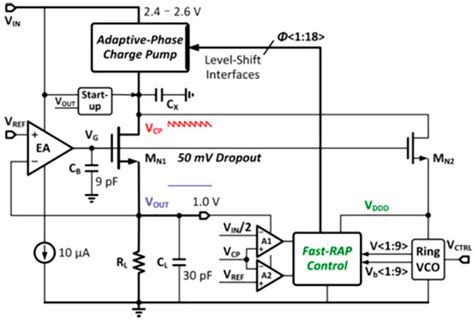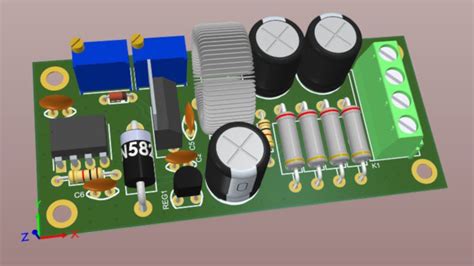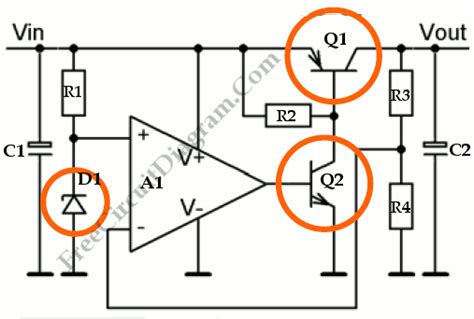What is an LDO Regulator?
An LDO regulator is a linear voltage regulator that can maintain a stable output voltage even when the input voltage is very close to the output voltage. The term “low-dropout” refers to the minimal difference between the input and output voltages required for the regulator to function properly. LDO regulators typically have a dropout voltage of less than 0.3V, making them suitable for low-voltage applications.
Advantages of LDO Regulators
- Low noise output
- Simple design and implementation
- Smaller footprint compared to switching regulators
- Lower cost than switching regulators
- Suitable for low-power applications
Disadvantages of LDO Regulators
- Lower power efficiency compared to switching regulators
- Limited current output capability
- Higher heat dissipation at high current loads
- Not suitable for applications with large input-output voltage differences
What is a Switching Regulator?
A switching regulator, also known as a switch-mode power supply (SMPS), is a type of voltage regulator that converts an input voltage to a desired output voltage by rapidly switching a power transistor on and off. This process allows the regulator to achieve high power efficiency, making it suitable for applications that require high current output or have large input-output voltage differences.
Advantages of Switching Regulators
- High power efficiency (up to 95%)
- Capable of handling high current loads
- Can step up (boost) or step down (buck) the input voltage
- Suitable for applications with large input-output voltage differences
Disadvantages of Switching Regulators
- Higher noise output due to high-frequency switching
- More complex design and implementation compared to LDO regulators
- Larger footprint than LDO regulators
- Higher cost than LDO regulators

LDO vs Switching Regulator: Key Differences
| Parameter | LDO Regulator | Switching Regulator |
|---|---|---|
| Power Efficiency | Low (30-60%) | High (up to 95%) |
| Noise Performance | Low noise output | Higher noise output |
| Size | Smaller footprint | Larger footprint |
| Cost | Lower cost | Higher cost |
| Current Output | Limited current output | High current output capability |
| Input-Output Voltage Difference | Suitable for small differences | Suitable for large differences |

Choosing Between LDO and Switching Regulators
When deciding between an LDO and a switching regulator for your PCB, consider the following factors:
- Power efficiency requirements
- Noise performance requirements
- Available PCB space
- Budget constraints
- Current output requirements
- Input-output voltage difference
Applications Suitable for LDO Regulators
- Low-power, battery-operated devices
- Noise-sensitive analog circuits
- Compact designs with limited PCB space
- Low-cost applications
Applications Suitable for Switching Regulators
- High-power applications
- Devices with large input-output voltage differences
- Applications requiring high current output
- Power-efficient designs

Implementing LDO and Switching Regulators on Your PCB
LDO Regulator Implementation
When implementing an LDO regulator on your PCB, consider the following guidelines:
- Choose an LDO with a dropout voltage suitable for your application
- Ensure the LDO’s current output capability meets your requirements
- Place the LDO close to the load to minimize voltage drop and noise
- Use proper decoupling capacitors at the input and output of the LDO
- Consider thermal management for high-current applications
Switching Regulator Implementation
When implementing a switching regulator on your PCB, consider the following guidelines:
- Select a switching regulator topology (buck, boost, or buck-boost) based on your input-output voltage requirements
- Choose a switching frequency that balances efficiency and noise performance
- Use proper inductor and capacitor values for optimal performance
- Place the switching regulator close to the load to minimize voltage drop and noise
- Implement proper layout techniques to minimize EMI and noise coupling
FAQ
-
Q: Can I use an LDO regulator for high-power applications?
A: While LDO regulators are generally not recommended for high-power applications due to their lower power efficiency, they can be used in certain cases where the current output requirements are met and the input-output voltage difference is small. -
Q: Are switching regulators always more expensive than LDO regulators?
A: In general, switching regulators are more expensive than LDO regulators due to their more complex design and additional components. However, the cost difference may be justified in applications where high power efficiency and high current output are critical. -
Q: Can I use a switching regulator for noise-sensitive analog circuits?
A: Switching regulators generate higher noise output compared to LDO regulators due to their high-frequency switching. If noise performance is a critical factor in your analog circuit, an LDO regulator may be a better choice. However, proper layout techniques and filtering can help mitigate noise issues in switching regulator designs. -
Q: How do I choose the appropriate decoupling capacitors for an LDO regulator?
A: When selecting decoupling capacitors for an LDO regulator, consider the following factors: capacitor value, voltage rating, equivalent series resistance (ESR), and placement. The capacitor value should be chosen based on the LDO’s stability requirements, while the voltage rating should exceed the maximum input voltage. Low ESR capacitors are preferred for better noise performance, and placement should be as close to the LDO as possible. -
Q: What is the difference between buck, boost, and buck-boost switching regulators?
A: Buck regulators step down the input voltage to a lower output voltage, boost regulators step up the input voltage to a higher output voltage, and buck-boost regulators can both step up and step down the input voltage. The choice between these topologies depends on your specific input-output voltage requirements.
Conclusion
Choosing between an LDO and a switching regulator for your PCB depends on various factors such as power efficiency, noise performance, size, cost, and current output requirements. LDO regulators are suitable for low-power, noise-sensitive applications with small input-output voltage differences, while switching regulators are ideal for high-power, power-efficient applications with large input-output voltage differences. By understanding the key differences between these two types of voltage regulators and considering your specific application requirements, you can make an informed decision and ensure optimal performance of your PCB design.

No responses yet